ECO mode MAZDA MODEL MX-5 MIATA 2006 User Guide
[x] Cancel search | Manufacturer: MAZDA, Model Year: 2006, Model line: MODEL MX-5 MIATA, Model: MAZDA MODEL MX-5 MIATA 2006Pages: 378, PDF Size: 4.01 MB
Page 150 of 378
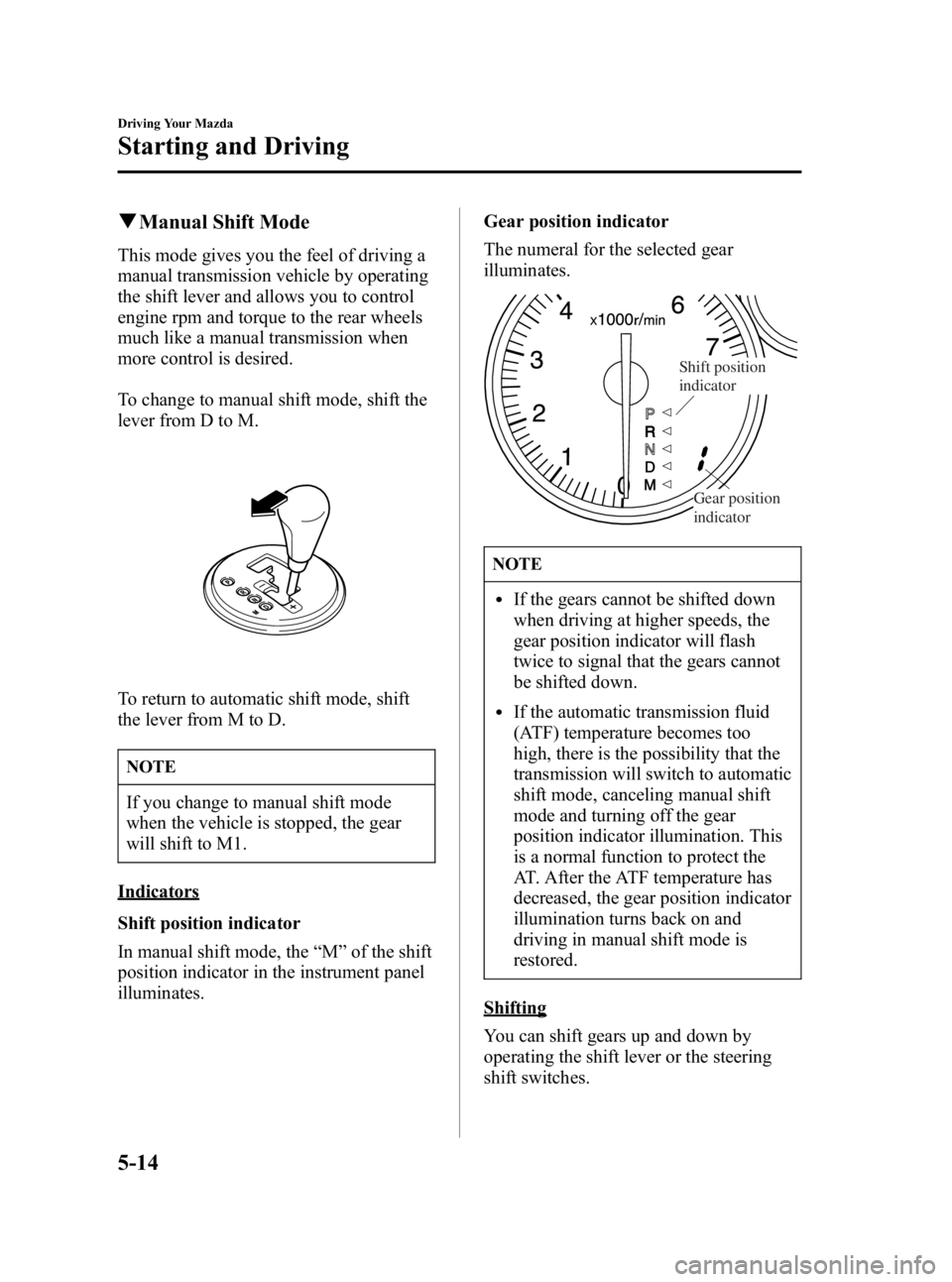
Black plate (150,1)
qManual Shift Mode
This mode gives you the feel of driving a
manual transmission vehicle by operating
the shift lever and allows you to control
engine rpm and torque to the rear wheels
much like a manual transmission when
more control is desired.
To change to manual shift mode, shift the
lever from D to M.
To return to automatic shift mode, shift
the lever from M to D.
NOTE
If you change to manual shift mode
when the vehicle is stopped, the gear
will shift to M1.
Indicators
Shift position indicator
In manual shift mode, the “M ”of the shift
position indicator in the instrument panel
illuminates. Gear position indicator
The numeral for the selected gear
illuminates.
Shift position
indicator
Gear position
indicator
NOTE
lIf the gears cannot be shifted down
when driving at higher speeds, the
gear position indicator will flash
twice to signal that the gears cannot
be shifted down.
lIf the automatic transmission fluid
(ATF) temperature becomes too
high, there is the possibility that the
transmission will switch to automatic
shift mode, canceling manual shift
mode and turning off the gear
position indicator illumination. This
is a normal function to protect the
AT. After the ATF temperature has
decreased, the gear position indicator
illumination turns back on and
driving in manual shift mode is
restored.
Shifting
You can shift gears up and down by
operating the shift lever or the steering
shift switches.
5-14
Driving Your Mazda
Starting and Driving
MX-5_8U35-EA-05F_Edition4 Page150
Thursday, October 6 2005 11:3 AM
Form No.8U35-EA-05F
Page 153 of 378

Black plate (153,1)
NOTE
lWhen driving at high speeds, the
gear may not shift down depending
on vehicle speed.
lDuring deceleration, the gear may
automatically shift down depending
on vehicle speed.
lWhen depressing the accelerator
fully, the transmission will shift to a
lower gear, depending on vehicle
speed (Except M2→M1).
Second gear fixed mode
When the shift lever is tapped back (
)
while the vehicle is stopped, the
transmission is set in the second gear
fixed mode. The gear is fixed in second
while in this mode for easier starting and
driving on slippery roads. If the shift lever
is tapped back (
) or forward () while
in the second gear fixed mode, the mode
will be canceled.
Shifting specification
Shifting up
If the vehicle speed is lower than the
speed specified for each gear, the gear
cannot be shifted up to a higher gear.
Gear Vehicle speed
M1 →M2 Between 0 and 18 km/h
(0 and 11 mph), depending on how
much the accelerator pedal is
depressed.
M2 →M3
M3 →M4 Between 22 and 32 km/h
(13 and 19 mph), depending on how
much the accelerator pedal is
depressed.
M4 →M5 Between 40 and 48 km/h
(25 and 29 mph), depending on how
much the accelerator pedal is
depressed.
M5 →M6 Between 50 and 68 km/h
(31 and 42 mph), depending on how
much the accelerator pedal is
depressed.
Shifting down
If the vehicle speed is higher than the
speed specified for each gear, the gear
cannot be shifted down to a lower gear.
Gear
Vehicle speed
M5 →M4 164 km/h (102 mph)
M4 →M3 117 km/h (72 mph)
M3 →M2 80 km/h (49 mph)
M2 →M1 35 km/h (21 mph)
During deceleration, the gears shift down
automatically when speed is reduced to
the following:
Gear Vehicle speed
M6 →M5 47 km/h (29 mph)
M5 →M4 38 km/h (23 mph)
M4 →M3 20 km/h (12 mph)
M3 →M2 15 km/h (9 mph)
M2 →M1 12 km/h (7 mph)
Driving Your Mazda
Starting and Driving
5-17
MX-5_8U35-EA-05F_Edition4 Page153
Thursday, October 6 2005 11:3 AM
Form No.8U35-EA-05F
Page 154 of 378
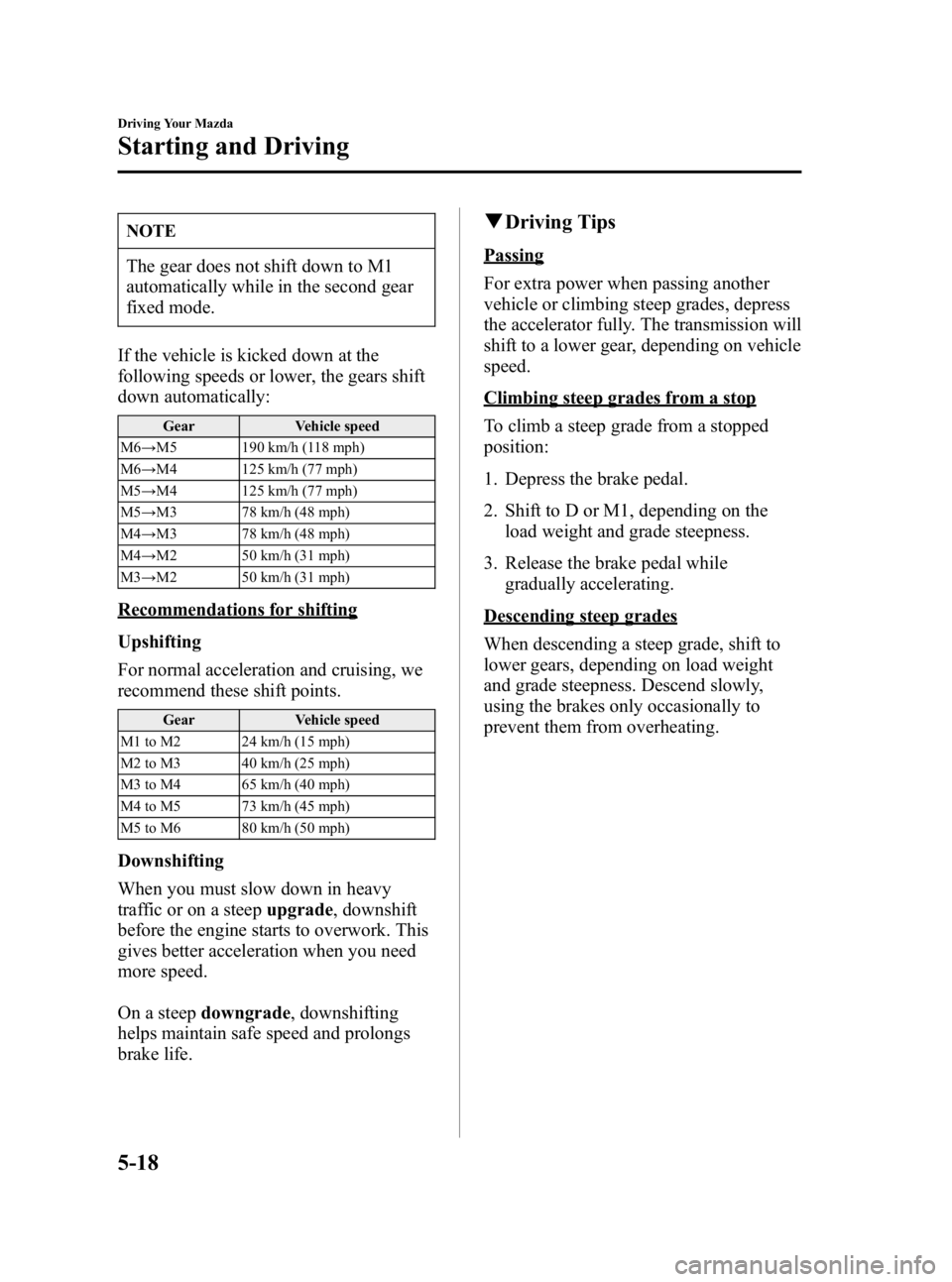
Black plate (154,1)
NOTE
The gear does not shift down to M1
automatically while in the second gear
fixed mode.
If the vehicle is kicked down at the
following speeds or lower, the gears shift
down automatically:
Gear Vehicle speed
M6 →M5 190 km/h (118 mph)
M6 →M4 125 km/h (77 mph)
M5 →M4 125 km/h (77 mph)
M5 →M3 78 km/h (48 mph)
M4 →M3 78 km/h (48 mph)
M4 →M2 50 km/h (31 mph)
M3 →M2 50 km/h (31 mph)
Recommendations for shifting
Upshifting
For normal acceleration and cruising, we
recommend these shift points.
Gear Vehicle speed
M1 to M2 24 km/h (15 mph)
M2 to M3 40 km/h (25 mph)
M3 to M4 65 km/h (40 mph)
M4 to M5 73 km/h (45 mph)
M5 to M6 80 km/h (50 mph)
Downshifting
When you must slow down in heavy
traffic or on a steep upgrade, downshift
before the engine starts to overwork. This
gives better acceleration when you need
more speed.
On a steep downgrade , downshifting
helps maintain safe speed and prolongs
brake life.
q Driving Tips
Passing
For extra power when passing another
vehicle or climbing steep grades, depress
the accelerator fully. The transmission will
shift to a lower gear, depending on vehicle
speed.
Climbing steep grades from a stop
To climb a steep grade from a stopped
position:
1. Depress the brake pedal.
2. Shift to D or M1, depending on the
load weight and grade steepness.
3. Release the brake pedal while gradually accelerating.
Descending steep grades
When descending a steep grade, shift to
lower gears, depending on load weight
and grade steepness. Descend slowly,
using the brakes only occasionally to
prevent them from overheating.
5-18
Driving Your Mazda
Starting and Driving
MX-5_8U35-EA-05F_Edition4 Page154
Thursday, October 6 2005 11:3 AM
Form No.8U35-EA-05F
Page 159 of 378
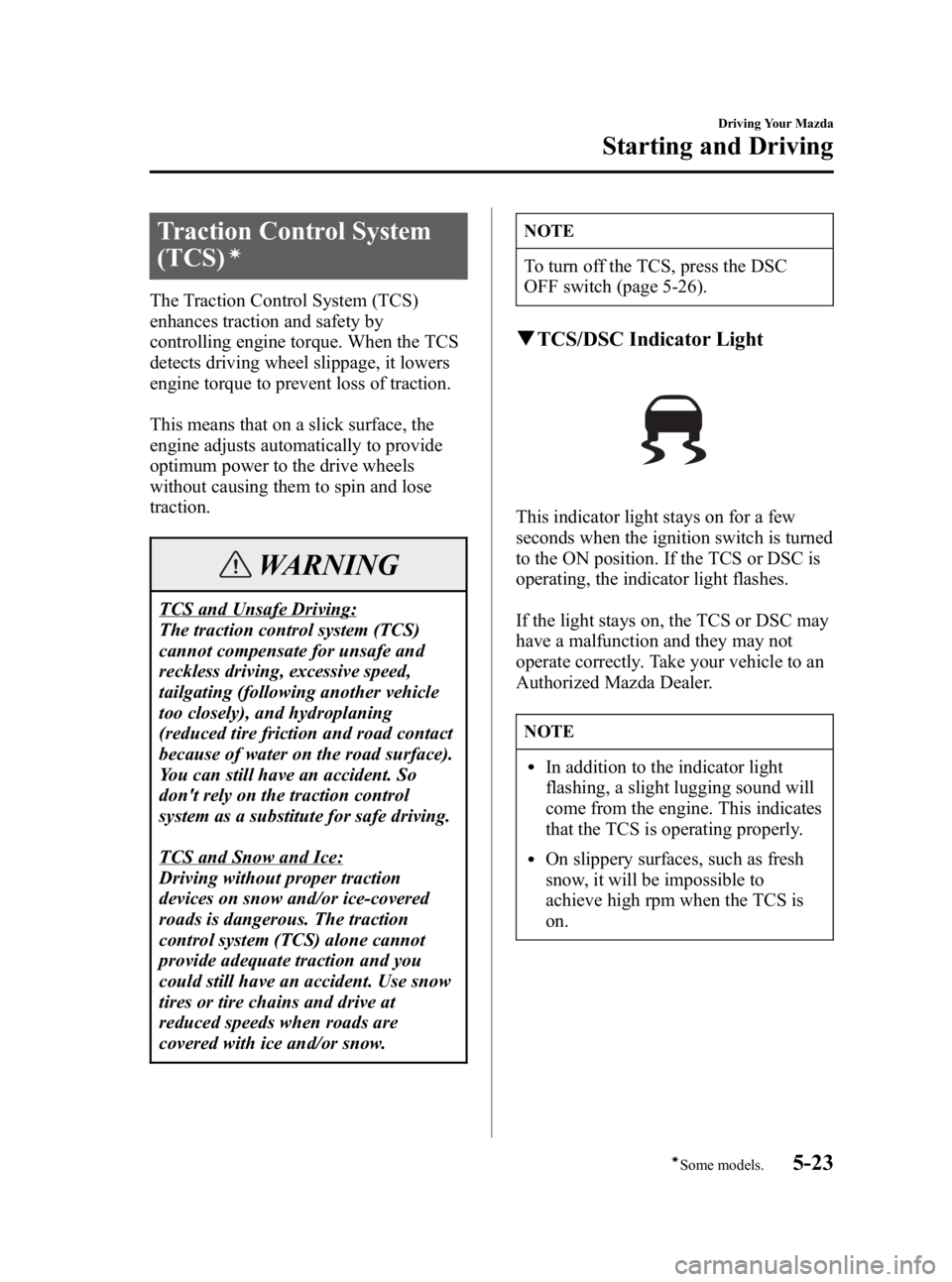
Black plate (159,1)
Traction Control System
(TCS)
í
The Traction Control System (TCS)
enhances traction and safety by
controlling engine torque. When the TCS
detects driving wheel slippage, it lowers
engine torque to prevent loss of traction.
This means that on a slick surface, the
engine adjusts automatically to provide
optimum power to the drive wheels
without causing them to spin and lose
traction.
WARNING
TCS and Unsafe Driving:
The traction control system (TCS)
cannot compensate for unsafe and
reckless driving, excessive speed,
tailgating (following another vehicle
too closely), and hydroplaning
(reduced tire friction and road contact
because of water on the road surface).
You can still have an accident. So
don't rely on the traction control
system as a substitute for safe driving.
TCS and Snow and Ice:
Driving without proper traction
devices on snow and/or ice-covered
roads is dangerous. The traction
control system (TCS) alone cannot
provide adequate traction and you
could still have an accident. Use snow
tires or tire chains and drive at
reduced speeds when roads are
covered with ice and/or snow.
NOTE
To turn off the TCS, press the DSC
OFF switch (page 5-26).
qTCS/DSC Indicator Light
This indicator light stays on for a few
seconds when the ignition switch is turned
to the ON position. If the TCS or DSC is
operating, the indicator light flashes.
If the light stays on, the TCS or DSC may
have a malfunction and they may not
operate correctly. Take your vehicle to an
Authorized Mazda Dealer.
NOTE
lIn addition to the indicator light
flashing, a slight lugging sound will
come from the engine. This indicates
that the TCS is operating properly.
lOn slippery surfaces, such as fresh
snow, it will be impossible to
achieve high rpm when the TCS is
on.
Driving Your Mazda
Starting and Driving
5-23íSome models.
MX-5_8U35-EA-05F_Edition4 Page159
Thursday, October 6 2005 11:3 AM
Form No.8U35-EA-05F
Page 160 of 378
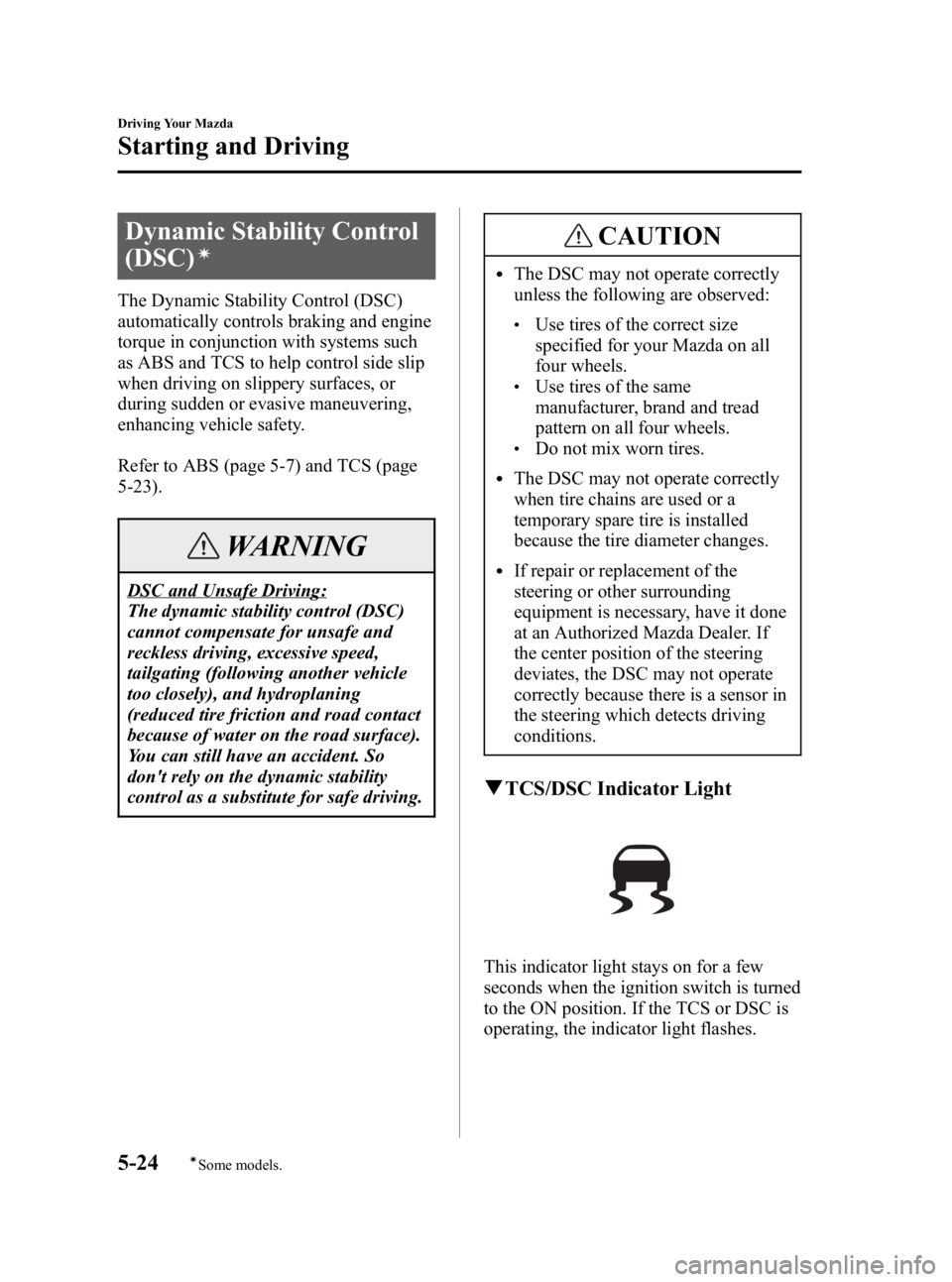
Black plate (160,1)
Dynamic Stability Control
(DSC)
í
The Dynamic Stability Control (DSC)
automatically controls braking and engine
torque in conjunction with systems such
as ABS and TCS to help control side slip
when driving on slippery surfaces, or
during sudden or evasive maneuvering,
enhancing vehicle safety.
Refer to ABS (page 5-7) and TCS (page
5-23).
WARNING
DSC and Unsafe Driving:
The dynamic stability control (DSC)
cannot compensate for unsafe and
reckless driving, excessive speed,
tailgating (following another vehicle
too closely), and hydroplaning
(reduced tire friction and road contact
because of water on the road surface).
You can still have an accident. So
don't rely on the dynamic stability
control as a substitute for safe driving.
CAUTION
lThe DSC may not operate correctly
unless the following are observed:
lUse tires of the correct size
specified for your Mazda on all
four wheels.
lUse tires of the same
manufacturer, brand and tread
pattern on all four wheels.
lDo not mix worn tires.
lThe DSC may not operate correctly
when tire chains are used or a
temporary spare tire is installed
because the tire diameter changes.
lIf repair or replacement of the
steering or other surrounding
equipment is necessary, have it done
at an Authorized Mazda Dealer. If
the center position of the steering
deviates, the DSC may not operate
correctly because there is a sensor in
the steering which detects driving
conditions.
qTCS/DSC Indicator Light
This indicator light stays on for a few
seconds when the ignition switch is turned
to the ON position. If the TCS or DSC is
operating, the indicator light flashes.
5-24
Driving Your Mazda
íSome models.
Starting and Driving
MX-5_8U35-EA-05F_Edition4 Page160
Thursday, October 6 2005 11:3 AM
Form No.8U35-EA-05F
Page 163 of 378
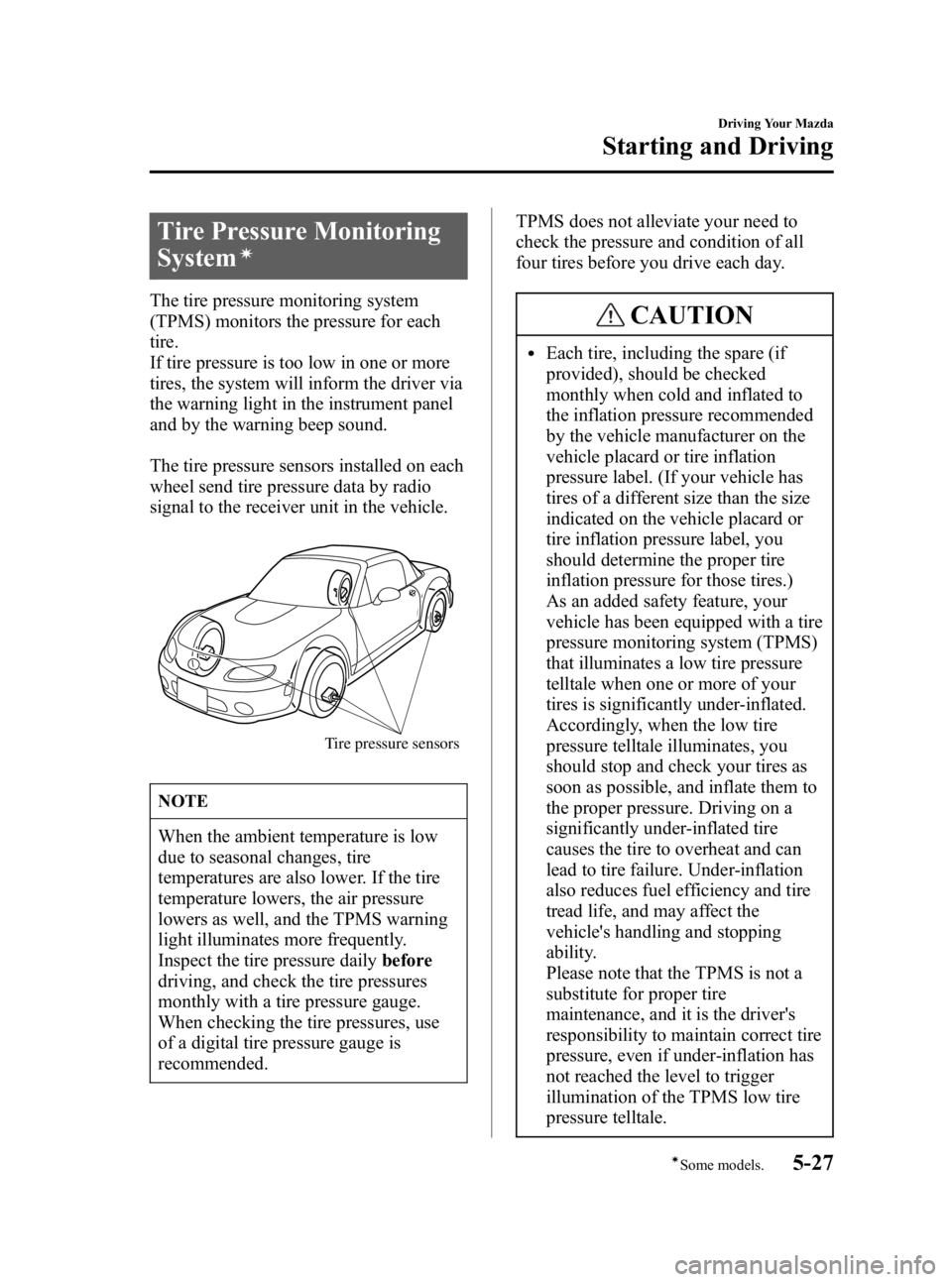
Black plate (163,1)
Tire Pressure Monitoring
System
í
The tire pressure monitoring system
(TPMS) monitors the pressure for each
tire.
If tire pressure is too low in one or more
tires, the system will inform the driver via
the warning light in the instrument panel
and by the warning beep sound.
The tire pressure sensors installed on each
wheel send tire pressure data by radio
signal to the receiver unit in the vehicle.
Tire pressure sensors
NOTE
When the ambient temperature is low
due to seasonal changes, tire
temperatures are also lower. If the tire
temperature lowers, the air pressure
lowers as well, and the TPMS warning
light illuminates more frequently.
Inspect the tire pressure dailybefore
driving, and check the tire pressures
monthly with a tire pressure gauge.
When checking the tire pressures, use
of a digital tire pressure gauge is
recommended. TPMS does not alleviate your need to
check the pressure and condition of all
four tires before you drive each day.
CAUTION
lEach tire, including the spare (if
provided), should be checked
monthly when cold and inflated to
the inflation pressure recommended
by the vehicle manufacturer on the
vehicle placard or tire inflation
pressure label. (If your vehicle has
tires of a different size than the size
indicated on the vehicle placard or
tire inflation pressure label, you
should determine the proper tire
inflation pressure for those tires.)
As an added safety feature, your
vehicle has been equipped with a tire
pressure monitoring system (TPMS)
that illuminates a low tire pressure
telltale when one or more of your
tires is significantly under-inflated.
Accordingly, when the low tire
pressure telltale illuminates, you
should stop and check your tires as
soon as possible, and inflate them to
the proper pressure. Driving on a
significantly under-inflated tire
causes the tire to overheat and can
lead to tire failure. Under-inflation
also reduces fuel efficiency and tire
tread life, and may affect the
vehicle's handling and stopping
ability.
Please note that the TPMS is not a
substitute for proper tire
maintenance, and it is the driver's
responsibility to maintain correct tire
pressure, even if under-inflation has
not reached the level to trigger
illumination of the TPMS low tire
pressure telltale.
Driving Your Mazda
Starting and Driving
5-27íSome models.
MX-5_8U35-EA-05F_Edition4 Page163
Thursday, October 6 2005 11:3 AM
Form No.8U35-EA-05F
Page 170 of 378

Black plate (170,1)
qSpeedometer
The speedometer indicates the speed of
the vehicle.
qOdometer, Trip Meter and Trip
Meter Selector
The display mode can be changed
between trip meter A and trip meter B by
pressing the selector while one of them is
displayed. The selected mode will be
displayed.
Trip meter
Odometer
Selector
Trip meter B
Press the selector
Press the selector
Trip meter A Odometer
Odometer
NOTE
The odometer and trip meter can be
displayed as follows even when the
ignition switch is in the ACC or LOCK
position.
lDisplays for 10 minutes after the
ignition switch is turned to the ACC
or LOCK position from the ON
position.
lDisplays for 10 minutes after the
driver's door is opened.
Odometer
The odometer records the total distance
the vehicle has been driven.
5-34
Driving Your Mazda
Instrument Cluster and Indicators
MX-5_8U35-EA-05F_Edition4 Page170
Thursday, October 6 2005 11:3 AM
Form No.8U35-EA-05F
Page 171 of 378
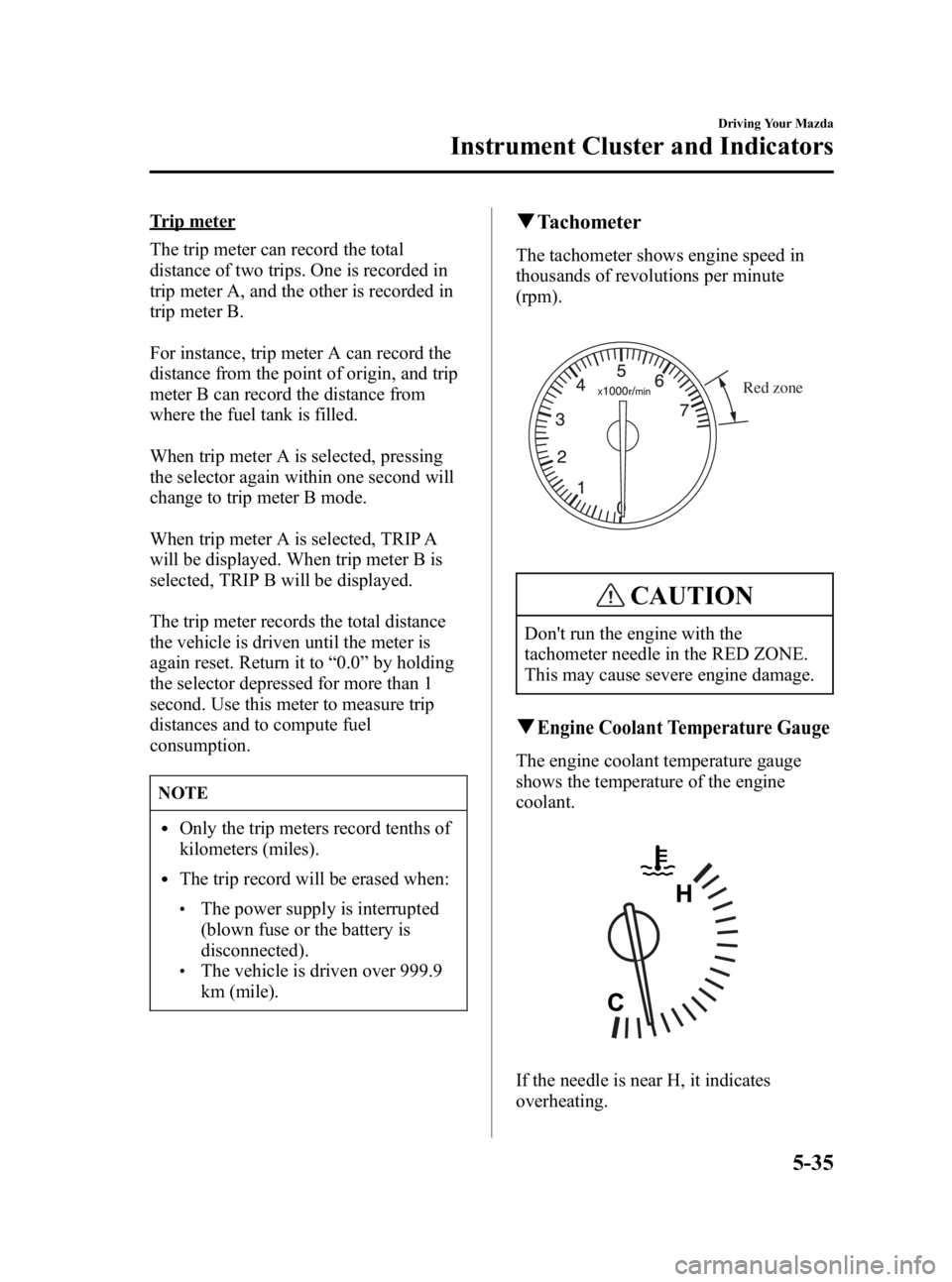
Black plate (171,1)
Trip meter
The trip meter can record the total
distance of two trips. One is recorded in
trip meter A, and the other is recorded in
trip meter B.
For instance, trip meter A can record the
distance from the point of origin, and trip
meter B can record the distance from
where the fuel tank is filled.
When trip meter A is selected, pressing
the selector again within one second will
change to trip meter B mode.
When trip meter A is selected, TRIP A
will be displayed. When trip meter B is
selected, TRIP B will be displayed.
The trip meter records the total distance
the vehicle is driven until the meter is
again reset. Return it to“0.0 ”by holding
the selector depressed for more than 1
second. Use this meter to measure trip
distances and to compute fuel
consumption.
NOTE
lOnly the trip meters record tenths of
kilometers (miles).
lThe trip record will be erased when:
lThe power supply is interrupted
(blown fuse or the battery is
disconnected).
lThe vehicle is driven over 999.9
km (mile).
q Tachometer
The tachometer shows engine speed in
thousands of revolutions per minute
(rpm).
Red zone
CAUTION
Don't run the engine with the
tachometer needle in the RED ZONE.
This may cause severe engine damage.
qEngine Coolant Temperature Gauge
The engine coolant temperature gauge
shows the temperature of the engine
coolant.
If the needle is near H, it indicates
overheating.
Driving Your Mazda
Instrument Cluster and Indicators
5-35
MX-5_8U35-EA-05F_Edition4 Page171
Thursday, October 6 2005 11:3 AM
Form No.8U35-EA-05F
Page 176 of 378
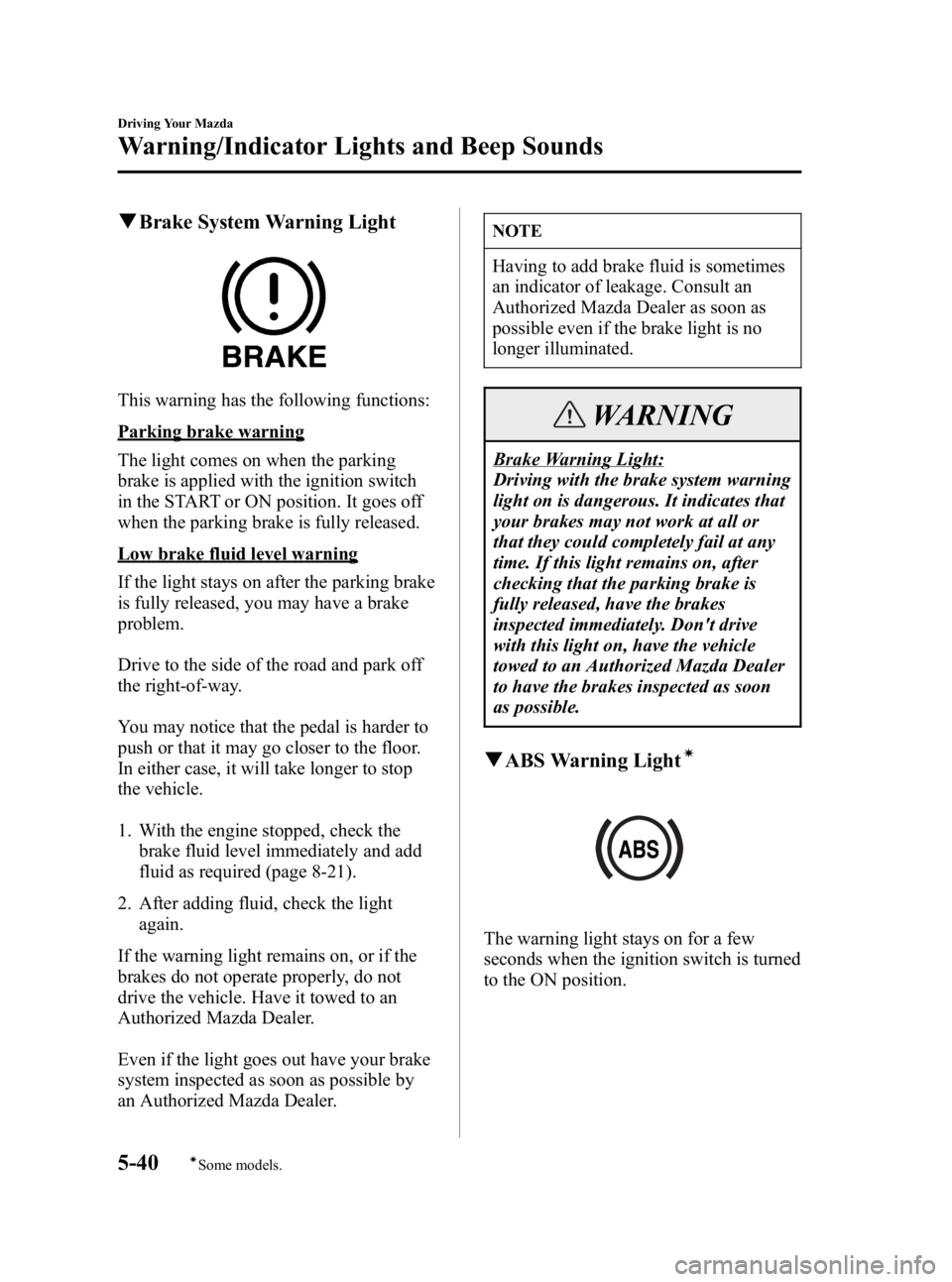
Black plate (176,1)
qBrake System Warning Light
This warning has the following functions:
Parking brake warning
The light comes on when the parking
brake is applied with the ignition switch
in the START or ON position. It goes off
when the parking brake is fully released.
Low brake fluid level warning
If the light stays on after the parking brake
is fully released, you may have a brake
problem.
Drive to the side of the road and park off
the right-of-way.
You may notice that the pedal is harder to
push or that it may go closer to the floor.
In either case, it will take longer to stop
the vehicle.
1. With the engine stopped, check the
brake fluid level immediately and add
fluid as required (page 8-21).
2. After adding fluid, check the light again.
If the warning light remains on, or if the
brakes do not operate properly, do not
drive the vehicle. Have it towed to an
Authorized Mazda Dealer.
Even if the light goes out have your brake
system inspected as soon as possible by
an Authorized Mazda Dealer.
NOTE
Having to add brake fluid is sometimes
an indicator of leakage. Consult an
Authorized Mazda Dealer as soon as
possible even if the brake light is no
longer illuminated.
WARNING
Brake Warning Light:
Driving with the brake system warning
light on is dangerous. It indicates that
your brakes may not work at all or
that they could completely fail at any
time. If this light remains on, after
checking that the parking brake is
fully released, have the brakes
inspected immediately. Don't drive
with this light on, have the vehicle
towed to an Authorized Mazda Dealer
to have the brakes inspected as soon
as possible.
q ABS Warning Lightí
The warning light stays on for a few
seconds when the ignition switch is turned
to the ON position.
5-40
Driving Your Mazda
íSome models.
Warning/Indicator Lights and Beep Sounds
MX-5_8U35-EA-05F_Edition4 Page176
Thursday, October 6 2005 11:3 AM
Form No.8U35-EA-05F
Page 181 of 378

Black plate (181,1)
qTire Pressure Monitoring System
(TPMS) Warning Lightí
This warning light illuminates for a few
seconds when the ignition switch is turned
to the ON position.
Thereafter, the warning light illuminates
when tire pressure is too low in one or
more tires, and flashes when there is a
system malfunction.
WARNING
Vehicle Handling When Tire Pressure
Monitoring System Warning Light
Illuminates/Flashes:
When the tire pressure monitoring
system warning light illuminates or
flashes, or the tire pressure warning
beep sound is heard, it is dangerous to
drive the vehicle at high speeds, or
perform sudden maneuvering or
braking. Vehicle drivability could
worsen and result in an accident.
When the tire pressure monitoring
system warning light illuminates or
flashes, or the tire pressure warning
beep sound is heard, decrease vehicle
speed immediately and avoid sudden
maneuvering and braking. Have the
system and tires checked or perform
the appropriate repair as soon as
possible by an Authorized Mazda
Dealer.
WARNING
Ignoring the Warning Light:
Ignoring the warning light is
dangerous, even if you know why it is
illuminated. Have the problem taken
care of as soon as possible before it
develops into a more serious situation
that could lead to tire failure and a
dangerous accident.
Warning light illuminates/Warning
beep sounds
When the warning light illuminates, and
the warning beep sound is heard (about 3
seconds), tire pressure is too low in one or
more tires.
Adjust the tire pressure to the correct tire
pressure. Refer to the specification charts
(page 10-6).
CAUTION
When replacing/repairing the tires or
wheels or both, have the work done by
an Authorized Mazda Dealer, or the tire
pressure sensors may be damaged.
Driving Your Mazda
Warning/Indicator Lights and Beep Sounds
5-45íSome models.
MX-5_8U35-EA-05F_Edition4 Page181
Thursday, October 6 2005 11:3 AM
Form No.8U35-EA-05F